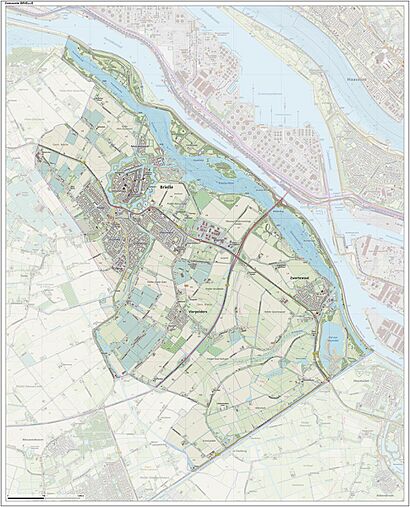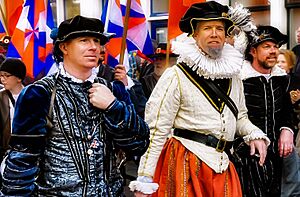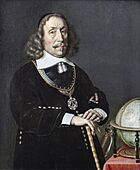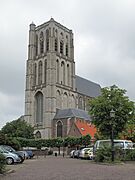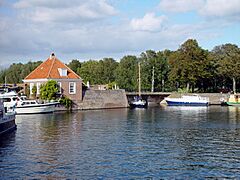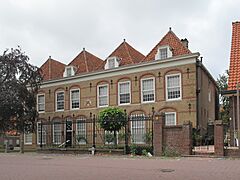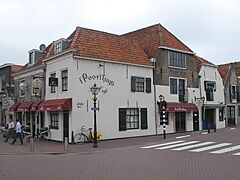Brielle facts for kids
Quick facts for kids
Brielle
Brill
|
|||
|---|---|---|---|

Historic town centre
|
|||
|
|||
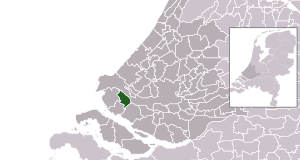
Location in South Holland
|
|||
| Country | Netherlands | ||
| Province | South Holland | ||
| Municipality | Voorne aan Zee | ||
| Area | |||
| • Total | 31.14 km2 (12.02 sq mi) | ||
| • Land | 27.56 km2 (10.64 sq mi) | ||
| • Water | 3.58 km2 (1.38 sq mi) | ||
| Elevation | 2 m (7 ft) | ||
| Population
(May 2014)
|
|||
| • Total | 16,350 | ||
| • Density | 593/km2 (1,540/sq mi) | ||
| Demonym(s) | Briellenaar | ||
| Time zone | UTC+1 (CET) | ||
| • Summer (DST) | UTC+2 (CEST) | ||
| Postcode |
3230–3232
|
||
| Area code | 0181 | ||
Brielle (also called Den Briel in Dutch and Brill in English) is a town and historic seaport in the western Netherlands. It is located in the province of South Holland, on the north side of the island of Voorne-Putten. The town is found at the mouth of the New Maas river.
Brielle used to be its own municipality. It covered an area of about 31 square kilometers, with some of that being water. In 2023, Brielle joined with Hellevoetsluis and Westvoorne to form a new, larger municipality called Voorne aan Zee. The former municipality of Brielle also included the smaller communities of Vierpolders and Zwartewaal.
Contents
History of Brielle
Brielle is a very old town with strong defenses. Its name comes from an old Celtic word, brogilo, which means "closed area" or "hunting grounds." Records show that the Brielle we know today is actually the "new" Brielle. An older version, Den ouden Briel (Old Brill), was located somewhere else on the Voorne-Putten Island.
Becoming a Town
Brielle grew into an important town in the 1300s. In 1330, Gerard van Voorne, who was the independent Lord of Voorne, gave Brielle "town rights." This meant the town could govern itself and make its own laws. It also gained special trading rights, like being able to trade fish and collect taxes from ships in its port. Brielle was the main seat for the Lords of Voorne for a long time. Later, in 1371, it became part of the County of Holland. The town had its own harbor and traded with countries around the Baltic Sea. Brielle even had its own trading post in Sweden.
The Capture of Brielle
A very important event in Dutch history happened in Brielle during the Eighty Years' War. This war was fought between the Netherlands and Spain. On April 1, 1572, a group of Protestant rebels called the Watergeuzen (Sea Beggars) captured Brielle. This event was a major turning point in the war. After Brielle was captured, many other towns in Holland started to support William I of Orange against the Spanish Duke Fernando Álvarez de Toledo, 3rd Duke of Alba.
This historic event is still celebrated every year on April 1st. The night before, people celebrate "Chalk Night" (kalknacht). During this night, the town is decorated with chalk or white paint. Dutch students learn a short rhyme to remember this important date, which also refers to April Fools' Day:
|
|
In Dutch, "de bril" means "the glasses" and sounds a lot like Den Briel. "Fles" sounds like Vlissingen (or Flushing), which was the next town the Dutch rebels captured. After Brielle was captured, some Catholic religious leaders were killed, and Brielle has since become a special place for pilgrimages.
English Connection
In August 1585, Brielle became one of three Dutch towns that were temporarily given to England. This happened through the Treaty of Nonsuch. Queen Elizabeth I received Brielle as a guarantee of payment for 5,000 soldiers. These soldiers, led by the Earl of Leicester, helped the Dutch in their fight against Spain. English soldiers were stationed in Brielle and at Flushing. The first English governor of Brielle was Thomas Cecil, 1st Earl of Exeter. He was followed by Edward Conway, 1st Viscount Conway, who even named his daughter Brilliana in honor of the town. In 1617, these cities were returned to the Netherlands.
Twin Cities
Brielle has special partnerships with other towns around the world. These are called "twin cities."
 Queenborough, on the Isle of Sheppey, in Kent, United Kingdom (since 1967)
Queenborough, on the Isle of Sheppey, in Kent, United Kingdom (since 1967) Havlíčkův Brod, Czech Republic (since 1985)
Havlíčkův Brod, Czech Republic (since 1985)
Notable People from Brielle
Many interesting people were born in or lived near Brielle:
- Anneke Esaiasdochter (1509 in Brielle – 1539), a Dutch Anabaptist who was executed for her beliefs.
- Willem Bloys van Treslong (1529–1594), a nobleman and one of the leaders of the Sea Beggars during the Capture of Brielle in 1572.
- Maarten Tromp (1598 in Brielle – 1653), a famous Dutch army general and admiral in the Dutch navy.
- Witte de With (1599 in Hoogendijk – 1658), a Dutch naval officer who served during the Eighty Years War and the First Anglo-Dutch war.
- Ludowyk Smits (1635 in Zwartewaal – 1707), a painter from the Dutch Golden Age.
- Philips van Almonde (1644 in Den Briel – 1711), a Dutch Lieutenant Admiral.
- Constantijn van Daalen (1884 in Brielle – 1931), a Dutch gymnast who competed in the 1908 Summer Olympics.
- Toon Tellegen (born 1941 in Brielle), a Dutch writer and poet, known for his children's books. He is also a physician.
Gallery
See also
 In Spanish: Brielle para niños
In Spanish: Brielle para niños




